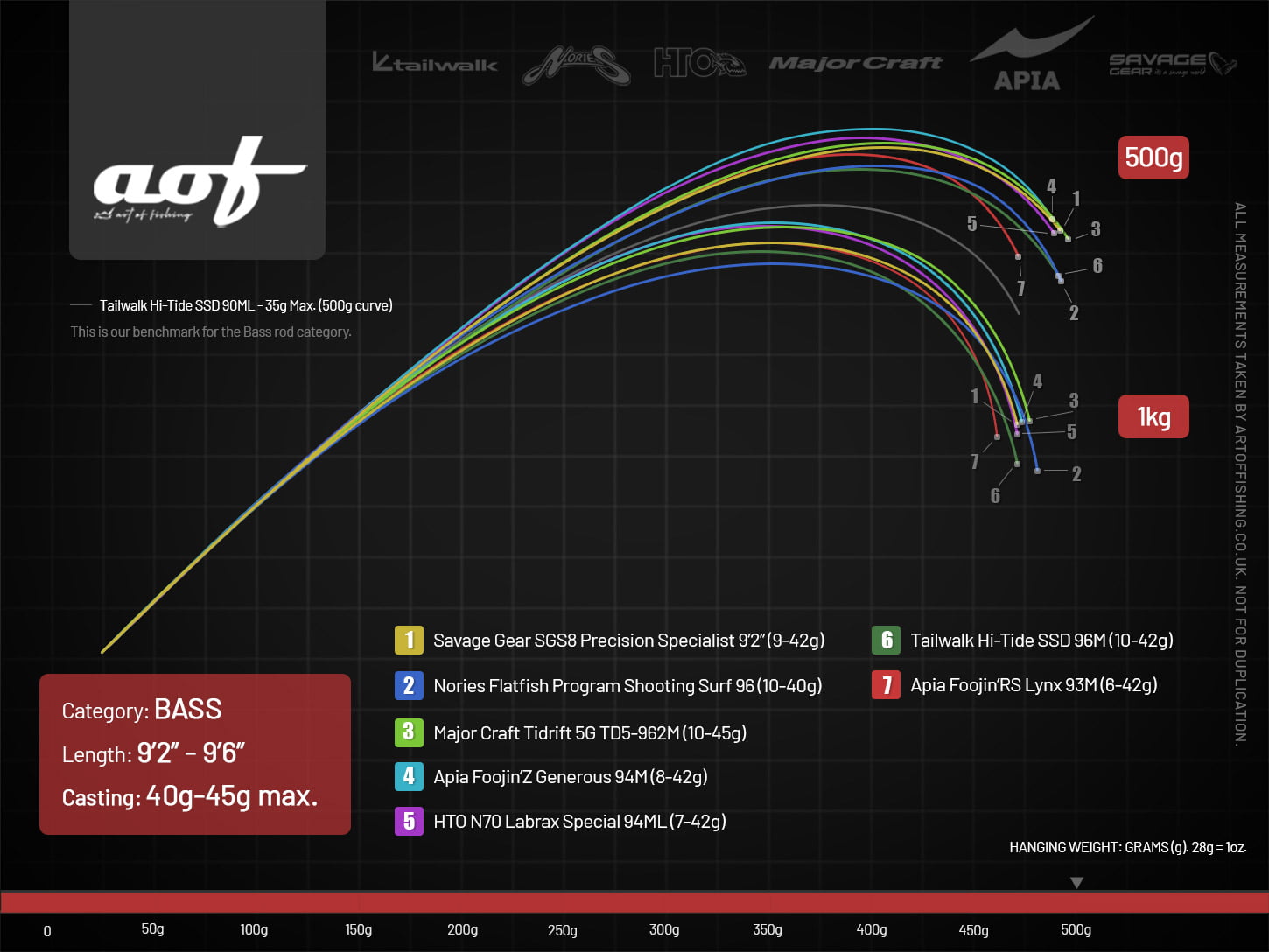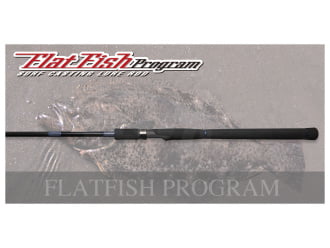Seven of the best middle-weight bass rods tested.
While our first couple of posts in the Getting Bent series were based around comparing rods within branded ranges, the third instalment is exactly what I know anglers really want to see.
By putting the microscope on similarly spec’d rods from different manufacturers – and mostly in similar price brackets – we can finally discover where each rod sits in comparison to the competition in terms of both power and action.
Rod specs alone tell you almost nothing unless you get good at reading the various diameter measurements (if they even tell you, and if they’re even accurate!). Casting weights give a rough idea of where the rod may sit, but with even that being unpredictable at times, we’re stuck in that spin of explaining how tricky it is to buy blind.
What do you prefer? Light tip, stiff tip, more elastic action or shed loads of power lower down?
Section Navigation
We’re taking a look at one of our most popular bass rod classes. The types of rods we tend to use for rougher conditions and longer distances.
- Category: Bass.
- Length: 9’2” – 9’6”.
- Maximum casting weights: 40g – 45g.
- Price: £200 – £700.
With rods from Apia, Major Craft, Tailwalk, HTO, Nories and Savage Gear put to the test, this is our chance to see how each compares. None of these rods featured are any I would say have abnormal ratings. I expect variations in the curves, but none to stand out as either being far more or less powerful than the ratings suggest.
THE RESULTS
Rod bending curves plotted: All rods, 500g and 1kg weight tests.

It should be a given that there is no right or wrong with either of these two attributes (action and power) and these charts are simply to show the differences between the rods. Understanding which action or power you prefer for your own circumstances will be completely up to you and I hope in a way that there may be a rod here somewhere that you’re familiar with to make it easier to picture. Simply because two curves are closely aligned is no reference to similar quality. It simply means that their action and power are similar. I sadly can’t calculate or visually recreate features such as tip recovery which is just one example that could create differences over these curves in the real fishing world.
To explain briefly how I tend to look at how each rod works, I like to split them down visually in to three or four parts:
- Tip (where we see initial movement).
- Middle of tip section (often helps demonstrate how fast the taper is).
- Lower tip section to joint (explains how the power kicks in).
- Mid-upper butt section (demonstrates rods truer power).
With so many rods on the chart, it’s not so simple to see exactly what’s going on, so I’ve split the rods in to three groups of relatively similar actions. Brand and price have no relevance.
Match 1: Savage Gear SGS8 9’2” – 42g vs. Apia Foojin’RS Lynx 93M
If there are two rods I would have said felt totally dissimilar in the flesh, it would have been these two. With the SGS8 we have a light, steely rod; while the Lynx feels stocky and solid. In this category I would have put the Lynx as one of the most powerful rods given the way it feels in the hand, but the curves do show how it bends.
The obvious difference between the two is in the tip, with the Lynx being far more elastic. It’s not soft, but very obviously more flexible.
I did wince while hanging 1kg on the SGS8. Light rods always scare me, but it managed it! From the middle of the tip section and down, they work in a similar way.
Saying that, I do think this is where the 1kg maximum that we use has its limitations. Although the curves look similar for the two, I think the difference less visible is the power in the butt of the Lynx. I felt like we could have put an extra 500g on it and I still wouldn’t have been worried about it breaking. You can see a little bit of this as the red line bumps above the yellow midway through the butt. But that’s Apia for ya! Fishable from the very tip, but the same rod could pull a bus. Anyway, I digress. In terms of action and what we actually see in the curves – which is all it’s really fair to base things on – they’re not all that dissimilar in what the two rods will do. The Lynx does it with a lighter tip, but actual power throughout the top 2/3 of the rod is quite close between the two.
-
Foojin’RS Lynx 93M
In stockLength: 9'3"£389.99
Casting - Max.: 42g
Casting - Min.: 6g
Sections: 2
Style: Spinning
Match 2:Apia Foojin’Z Generous 94M vs. Major Craft Triple Cross 96M vs. HTO N70 94ML
 Again, a collection of rods picked because of their rough similarities on the charts.
Again, a collection of rods picked because of their rough similarities on the charts.
To get the most similar of the lot out of the way first, the N70 and the Generous are about as close as we’ll find given no link between brands. Totally different rods in the flesh – with the N70 being very steely and actually quite stiff (I like selling them for those exact reasons though) and the Generous a little more “refined”. More elastic, but with the typical Apia power. The fact that the Generous comes out as the most powerful of the lot in these tests is a real surprise given how easy and refined they do feel in the hand (they’re not cheap though!). I was expecting it to be less powerful than the Lynx above for example, but the opposite is actually true.
The Generous is very slightly lighter in the tip than the N70 but when the power kicks in it holds the whole thing up. With 1kg on the end they are obviously so, so similar, power wise.
The interesting one of the bunch is the Major Craft Tidrift though…
We’ve sold Major Craft rods for a long, long time and they’ve always been right up there in terms of value for money. I’ve had the pleasure of fishing with this version of the Tidrift and can tell you it’s a lovely rod to use for anything slightly more beefy. A physically light rod with a nice tip action, you can see this on the charts.
Rated to 45g you’d think it’d top the power levels among this bunch. Like in some of the earlier posts though, there is a bit of physics going on with the extra length is has over the two. This can partly explain why it dips below both in the 500g test. It’s not the main reason though…
Throughout the blank we have what I would expect is just a slower taper which spreads the power. What’s actually happening is that the bottom part of the tip section on the Tidrift is slightly stiffer than the other two rods. This spreads extra pressure down towards and through the butt section – which means the whole thing dips as it’s being forced to bend further down. So it’s not that the rod is less powerful, it’s just that when one area refuses to bend, another needs to take some of the strain. So how I picture the Tidrift having been constructed is with a fast taper tip, but a slower taper blank. Either that or they’ve done something with the way the carbon is wrapped to stiffen up the base of the tip section. Interesting rod.
-
Foojin’Z Generous 94M
In stockLength: 9'4"£679.99
Casting - Max.: 42g
Casting - Min.: 8g
Sections: 2
Style: Spinning -
N70 Labrax Special 9’4″ – N7094ML
In stockLength: 9'4"
Casting - Max.: 42g
Casting - Min.: 9g
Sections: 2
Style: Spinning£425.99Original price was: £425.99.£409.99Current price is: £409.99.-4% OFF
Match 3:Nories Flatfish Program 96 vs. Tailwalk Hi-Tide SSD 96M
 Of the rods tested, these two stand out for their slightly more progressive curves. What they do is different, and one in particular I find really interesting.
Of the rods tested, these two stand out for their slightly more progressive curves. What they do is different, and one in particular I find really interesting.
The Hi-Tide SSD is one of, if not our most popular range of rods. At circa-£200 they are amazing value. An extended version of our benchmark 90ML used in every chart we produce, the 96M is not the fastest action rod, but that’s what makes it great. “Fastness” is a funny thing though. I’ll post about it later.
The most interesting rods of all these tests is the Nories Flatfish Program Shooting Surf 96. Technically a Japanese “Flatfish” rod, they shouldn’t be overlooked for our bass fishing. Our bass fishing is often much more like the Japanese flatfish style than it is their seabass one – given the lures they use and where they do it. Diving plugs, lots of soft plastics, metals… open coast…. Sound familiar?
Typically the Flatfish rods are slightly more progressive in action. We see that on the chart. But what the Shooting Surf does and where it does it is interesting.
The tip is not stiff. A bit like the Generous or the Tidrift. We only really see it in the 500g curve before everything else starts to work. However, the similarities with the Tidrift continue even though it wasn’t the intention with this match-up. The extra power of the Tidrift made it less obvious until now. The Tidrift does have a touch more power in the base of the tip section. The Nories then has the less pokey butt, which we see quite obviously against the others. It’s not soft of spongey being such a high-quality rod, but it does bend. The purpose of that is to cast efficiently!
I owned and fished the 8’8” model of this rod for years. I like interesting rods, and this is that!
-
Hi-Tide SSD 96M
In stockLength: 9'6"£219.99
Casting - Max.: 42g
Casting - Min.: 10g
Sections: 2
Style: Spinning -
Flatfish Program Shooting Surf 96
In stockLength: 9'6"£559.99
Casting - Max.: 40g
Casting - Min.: 10g
Sections: 2
Style: Spinning
The Getting Bent Summary
Firstly, I apologise if that one was a bit of a slog given so many rods to talk about. I’m working at the moment on a website feature that will automate so much of this stuff so that you can play with it in your own time.
Regardless of my many words, hopefully the pictures and charts at least give you a way of spotting some of the differences yourselves, and come up with your own theories about certain features.
There were definitely a few surprises for me while running through these curves. We’ll sort future posts for lighter and shorter rod comparisons too.









